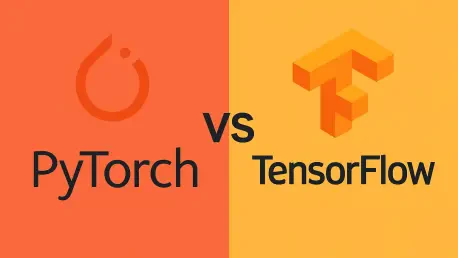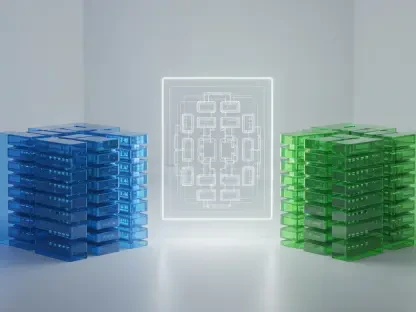In the rapidly advancing realm of artificial intelligence, selecting the optimal deep learning framework is a pivotal decision that can significantly influence the success of a project, whether it’s a groundbreaking research endeavor or a large-scale commercial application. As the landscape stands today, PyTorch and TensorFlow continue to dominate as the leading frameworks, each carving out distinct niches with their unique capabilities and dedicated user bases. This comparison isn’t merely a technical face-off; it’s a deep dive into what fuels innovation, scalability, and community engagement in the AI sphere. For researchers pushing the boundaries of neural network design or developers deploying robust systems in production environments, understanding the nuances of these tools is essential. This exploration aims to shed light on critical aspects like usability, performance metrics, and deployment strengths, guiding professionals toward the framework that best aligns with their specific goals and challenges in the dynamic field of deep learning.
Developer Experience: Balancing Intuition and Structure
The ease of use and design philosophy of a framework often determine how quickly developers can bring their ideas to life, and here PyTorch stands out with its inherently dynamic approach. Known for a define-by-run paradigm, it allows for real-time model adjustments, which proves invaluable for those in research who need to experiment and debug rapidly. This flexibility mirrors the natural flow of Python programming, making it feel almost seamless to code complex architectures. The clarity of error messages further enhances the debugging process, reducing frustration during iterative development. For anyone accustomed to Python’s syntax and modularity, PyTorch offers a welcoming environment that encourages creative exploration without imposing steep learning curves or rigid constraints, positioning it as a go-to for academic and experimental projects where adaptability is key.
On the other hand, TensorFlow brings a different flavor to the table with a historically more structured approach that has evolved significantly over time to meet user demands for simplicity. With the introduction of eager execution in its later versions, it has bridged some of the gap with PyTorch’s dynamic nature, offering a more intuitive coding experience than its earlier static graph model. The integration of the Keras API provides a high-level abstraction that streamlines common tasks, though delving into intricate customizations can still reveal steeper complexity. Where TensorFlow truly shines is in its suite of visualization tools, such as TensorBoard, which offers detailed insights into model behavior—a feature that remains more comprehensive than similar offerings in PyTorch. For developers who value a balance of structured workflows and robust diagnostic tools, TensorFlow presents a compelling case, especially in settings where monitoring and refining models over time are critical to project success.
Performance Metrics: Measuring Speed and Scalability
When evaluating raw computational efficiency, PyTorch frequently emerges as the frontrunner, particularly in scenarios involving the training of large-scale models with extensive datasets. Its adept memory management and optimized CUDA interactions enable it to achieve training speeds that can surpass TensorFlow by significant margins, with some benchmarks indicating up to a 25% advantage in convolutional neural network tasks. This edge becomes especially pronounced when handling dynamic architectures, where PyTorch’s ability to adapt on the fly minimizes resource waste. For smaller batch inference workloads, it also demonstrates lower latency, making it an attractive option for applications requiring quick responses. This performance profile suits environments where rapid iteration and handling of complex, evolving models are paramount, ensuring that computational bottlenecks do not hinder progress.
TensorFlow, however, holds its own in performance arenas, particularly when the focus shifts to specific hardware integrations and varied input sizes. It often shows greater efficiency with smaller data batches due to reduced overhead, which can be a deciding factor in lightweight applications. The framework’s seamless integration with TPUs provides a distinct advantage in massive, distributed training setups, catering to enterprises managing vast computational resources. While PyTorch competes strongly with features like Distributed Data Parallel for GPU scaling, TensorFlow’s memory usage can pose challenges without careful manual optimization, sometimes leading to fragmentation issues. Both frameworks excel in distributed training capabilities, but the choice often hinges on the specific hardware ecosystem and the scale of operations, with TensorFlow slightly favoring those already invested in TPU-driven infrastructures for expansive, long-term projects.
Deployment Capabilities: From Prototype to Production
In the critical domain of deployment, TensorFlow asserts dominance with a comprehensive ecosystem tailored for transitioning models from development to real-world application across diverse platforms. Its suite of tools, including TensorFlow Lite for mobile and embedded devices, and TensorFlow.js for web-based solutions, ensures seamless integration into varied environments. For server-side needs, TensorFlow Serving optimizes high-throughput model deployment, making it a preferred choice for industries requiring dependable, scalable rollouts. This robust infrastructure supports advanced techniques like quantization and hardware acceleration, particularly through TensorFlow Lite Micro for TinyML applications on edge devices. Such capabilities make TensorFlow a cornerstone for enterprises aiming to deliver AI solutions with minimal latency and maximal compatibility in production settings where reliability is non-negotiable.
PyTorch, while making significant strides in deployment, still plays catch-up to TensorFlow’s mature ecosystem, though its progress is noteworthy for those invested in its framework. PyTorch Mobile enables deployment on Android and iOS platforms, yet it often carries a heavier runtime footprint compared to the lightweight efficiency of TensorFlow Lite. Innovations like TorchServe, developed in collaboration with major cloud providers, offer viable server deployment options, and ONNX export enhances interoperability across different systems. Despite these advancements, the deployment tools lack the polish and breadth of TensorFlow’s offerings, sometimes requiring additional effort for optimization. For projects where production deployment is the ultimate goal, TensorFlow generally provides a more streamlined path, though PyTorch’s ongoing improvements suggest a narrowing gap that could appeal to developers seeking flexibility alongside emerging deployment solutions.
Community and Ecosystem: Adoption Across Domains
The strength of a framework often lies in its community support and ecosystem, where PyTorch has carved a dominant niche within academic and research circles due to its adaptability. Surveys and conference data reveal its widespread use in cutting-edge studies, with a significant majority of recent AI research papers leveraging its modular libraries like Hugging Face Transformers for natural language processing tasks. This preference stems from an environment that fosters experimentation through accessible tools and a supportive developer base sharing innovative solutions. Specialized extensions, such as PyTorch Geometric for graph neural networks, further cement its position as a leader in exploratory domains. For those immersed in pushing the boundaries of AI theory and novel applications, the vibrant academic ecosystem around PyTorch provides an unparalleled resource pool of knowledge and collaboration opportunities.
Conversely, TensorFlow enjoys a stronghold in industrial applications, underpinned by a monolithic ecosystem that integrates seamlessly with enterprise needs for scalability and maintenance. Official libraries spanning vision, language processing, and MLOps pipelines, alongside platforms like TensorFlow Hub, offer ready-to-use components that streamline deployment in production environments. Industry surveys consistently highlight TensorFlow’s prevalence in commercial settings, where its comprehensive tools for model management and optimization are critical for large-scale systems. Its robustness supports high-stakes applications, from recommendation engines to real-time translation services, where stability trumps experimental flexibility. For organizations prioritizing proven, end-to-end solutions over rapid prototyping, TensorFlow’s established community and extensive documentation provide a reliable foundation for tackling complex, operational challenges in AI deployment.
Future Pathways: Convergence and Choice
Reflecting on the journey of these frameworks, the competition between PyTorch and TensorFlow has proven to be a driving force for innovation, benefiting the broader AI community through relentless improvements. Both adapted to user feedback over time, with TensorFlow embracing dynamic execution to rival PyTorch’s flexibility, while PyTorch bolstered its deployment arsenal to challenge TensorFlow’s production dominance. This mutual evolution narrowed historical divides, fostering interoperability through standards like ONNX and multi-backend support in tools such as Keras 3.0. The result is a landscape where neither framework stands as the unequivocal champion; instead, their complementary strengths cater to diverse needs across research and industry.
Looking ahead, the focus should shift toward strategic alignment with project objectives when choosing between these powerhouses. Developers and researchers are encouraged to assess specific requirements—whether prioritizing rapid experimentation or robust scalability—and leverage the growing synergy between the frameworks. Exploring hybrid approaches, where elements of both are utilized via interoperable tools, could unlock new efficiencies. As the AI field continues to advance, staying attuned to community updates and emerging integrations will be crucial for harnessing the full potential of deep learning technologies, ensuring that the choice of framework becomes a tailored decision rather than a definitive verdict.









